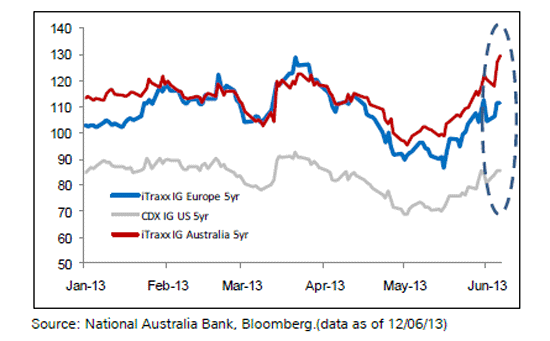
By Craig Simpson
In their latest Credit Monthly Report, BNZ note a sea-change in market sentiment has occurred over the past 2 weeks.
The catalysts behind this shift are the prospect of US Fed tapering back their QE III program, and sluggish global growth.
Both events have spooked investors and forced global bond yields to rise (in other words bonds have been sold-off).
Since the Fed's announcement yields have risen significantly. In NZ swap rates have increased by 25 basis points and there has been a clear steepening of the yield curve.
So far in June NZ swap rates have risen from between 2bps (1-year) to 16bps (5,7 & 10-year).
Rising bond yields are negative for investors who have purchased their holdings when yields have been at their lowest points.
Outlook for NZ & Australian credit markets
As reported in my market summary for May, investors holding a diversified portfolio of global sovereign bonds will have lost approximately 1.4% of the value of their investments.
For the NZ credit market much of the NZ economic data and news of late has been substantially stronger than the RBNZ expected.
Overall, this string of positive data has to be supportive for NZ's credit quality and corporate earnings.
Likewise for Australia, BNZ suggests the most recent economic forecasts support a constructive (low interest rate) outlook for Aussie credit markets.
The Australian forecasts are based on assumptions that Australian GDP for 2013 will be (unchanged at) 2.3% but that 2014 GDP will be 2.8% (lowered from 3.1%) as mining capex looks to be slowing by more than expected and recovery in other areas is less than expected.
The latest revisions in BNZ's economists' forecasts for NZ & Australia reflects a 'constructive outlook' for the NZ and Australian credit markets.
More risk reflected in credit default swap (CDS) spreads
A credit default swap (CDS) is a financial agreement whereby the seller of the CDS will compensate the buyer in the event of a loan default or other specified credit event. The buyer of the CDS makes a series of payments (the CDS "fee" or "spread") to the seller and in exchange, receives a payoff if the loan defaults.
Here at interest.co.nz we commented recently credit spreads have been steadily rising since early May and are now at their highest levels of 2013 and that they have risen by approximately one third in the past six weeks.
Looking further a field, NZ Government sovereign CDS spreads are up by a quarter over the same period and China's sovereign spreads have moved higher and even more sharply.
BNZ in their research paper note there have been a considerable up-tick in the CDS spread for European, US and Australian investment grade CDS's as illustrated by a circle in the graph below.
Credit default swap spreads (CDS) for Australia for example, basically reflects risk on investment grade Aussie bank debt.

CDS spreads rise and fall with the fortunes of the market and can be used to monitor how the market views credit risk of any entity, country or region on which a CDS is available.
The graph above also illustrates another period in early March where the perceived risk in these three markets increased sharply before subsiding in April through to mid-May.
The rise in CDS spreads coincides with the latest US Fed announcement.
Eurozone needs yields to stay low
The Eurozone is still in technical recession and looking likely to remain structurally impaired for the foreseeable future according to BNZ.
They see European credit market yields being dragged higher in sympathy with those stronger regions (US, Asia?, New Zealand), at exactly the time that yields need to stay low so that Eurozone recovery hopes can establish roots.
The general expectation is European bonds will under-perform their US counterparts.
One of the key points in BNZ's report is there has been far too great a reliance on cheap financing to keep low-rated (or even unrated) issuers afloat over the past couple of years.
They note a higher rate structure will be seen as judgment day for some of these issuers and in their opinion any sustained rise in European yields could be disastrous for European risk assets, strangling fledgling growth expectations.
They go on to say "the Eurozone has bigger structural and political fish to fry both on the ‘periphery’ and at the ‘core’ over the coming months and that as such any out-performance relative to the US recovery is unlikely."
From a trading strategy and macro fundament strength perspective BNZ favours dollar-bloc (NZD, AUD, USD) and GBP paper over Euro-denominated equivalents.
Note also that Germany’s top Congressional Court is meeting to discuss the legality (or otherwise) of the ECB’s support mechanisms for the Eurozone. Arguments are the ECB has over-stepped its mandate by offering a back-stop financing bid for bankrupt (Eurozone peripheral) member states. A ruling on this is not due until September however the ongoing uncertainty could increase risk and unnerve some investors.
US economic improvement
The rating agency Standard & Poor's (S&P) opined that its (AA+/A-1+, affirmed) ratings on the US ‘primarily reflect our view of the strengths of the US economy and monetary system, as well as the US dollar's status as the world's key reserve currency.
The ratings also take into account the high level of US external indebtedness; S&P's view of the effectiveness, stability, and predictability of US policy making and political institutions; and the US fiscal performance.
The upgrade of the outlook to stable from negative reflects that some of the drivers which could have seen a credit downgrade have abated and S&P says 'the likelihood that we will lower the rating in the near term is less than one in three.'
Other Credit Market News:
- The next LGFA tender is on Wednesday 19 June with details released on Monday 17 June.
- S&P affirmed Whangarei District Council’s ratings as AA-/A-1+ with a stable outlook.
- The A- rating of Morgan Stanley and Merrill Lynch were affirmed at A-.
- Wellington International Airport printed $50m of bonds, selling $25m each of a 6yr FRN at BKBM+130bps and a 7yr fixed rate line at swap+150bps.
- KfW printed a NZ$100m 5yr EMTN at swap+25bps.
- AMP Bank was upgraded to A+/Stable from A/Stable and subsequently AMP Group Finance Services was also upgraded from A/Stable to A+/Stable.
- Genesis Energy announced the pricing on the restructure of its capital bonds, with the interest rate to be set on 10 July 2013 at the higher of 5.80% or 5yr swap+215bps. This is down from 8.50% and +387bps respectively to reflect the reduction in equity content to intermediate, which in turn is expected to increase the credit rating from BB- to BB+.
- S&P released an announcement saying that Heartland Bank’s BBB-/A-3 issuer credit rating is unchanged following its property review and updated financial guidance. Its outlook remains negative.
- S&P affirmed the rating on Palmerston North City Council as AA/A-1+ with a stable outlook.
- Moody’s announced that it has put on review for downgrade the subordinated debt ratings on eight Australian banks. The review is expected to be completed within the next three months.
- EIB issued EUR3b of a new 10yr at swap+25bps or around BKBM+102bps.
- Kommunalbanken Norway issued NZ$200m of a new 12/2017 Kauri at swap+40bps or NZGB+88.3bps.
- NAB issued EUR750m of a 12yr covered bond at swap+33 or around BKBM+115bps (a record tenor for Australian banks).
New free daily fixed income newsletter
We have recently commenced a new free daily fixed income newsletter which provides subscribers with a daily pricing sheet as well as bond and economic stories. If you would like to receive this email directly into your inbox please sign up below.
To subscribe enter your email address here.
This newsletter also gives you convenient links to each of the corporate bond issues and issuers.
Anyone can sign up (you don't need to register first), although you will be prompted for verification from your email Inbox. You can unsubscribe at any time.
You will receive it every day in the early afternoon.
No chart with that title exists.
1 Comments
Methinks this trend will be short-lived, words are cheap. Wait till the US Fed gets a real taste of what the funny money equity markets think of their free dosh disappearing! It will be back to QE with a vengance. Re Australia; their economy will be much stronger than current punters think - once they are free of Labour's weird taxes and policies.
Ergophobia
We welcome your comments below. If you are not already registered, please register to comment.
Remember we welcome robust, respectful and insightful debate. We don't welcome abusive or defamatory comments and will de-register those repeatedly making such comments. Our current comment policy is here.